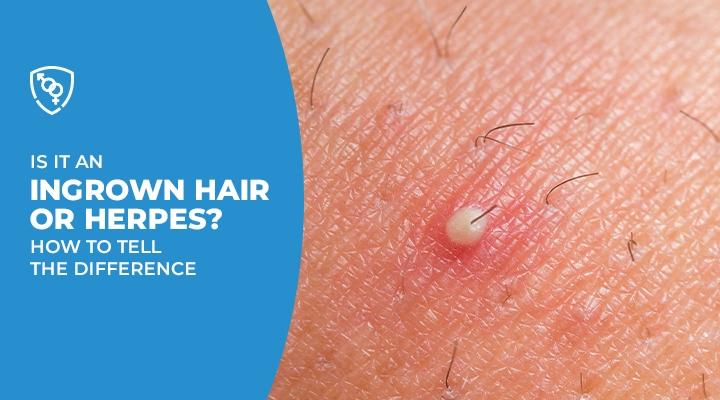Noticing a bump in your pubic or genital area can be stressful, but not every bump is an STD. Ingrown hairs, razor irritation, and herpes can look alike, which is why many people wonder whether they’re dealing with ingrown hair or herpes.
This guide explains the key differences, what symptoms to watch for, and when to get checked by a medical professional. For clarity and peace of mind, Manhattan STD Testing provides fast, confidential evaluations, including our dedicated herpes testing and comprehensive STD panel for complete peace of mind.
What Is Ingrown Hair?
An ingrown hair occurs when a hair grows back into the skin instead of rising to the surface. This is extremely common in the pubic region, particularly for people who shave, wax, trim, or experience friction from tight clothing.
What does an ingrown hair look like?
- A small, raised red bump
- Typically located exactly where a hair usually grows
- A visible dark hair trapped under the skin
- A white or yellow head (pus)
- Often itchy or mildly tender
- Usually heals within a few days to a week
Ingrown hairs are not contagious and are generally harmless, though they can become irritated or infected (folliculitis) if picked at.
What Is Genital Herpes?
Genital herpes is caused by the herpes simplex virus (HSV-1 or HSV-2). It can appear anywhere on the genitals, including pubic areas with hair.
What does a herpes bump look like?
- Small, fluid-filled blisters
- Usually appear in clusters, though a single bump is possible
- Blisters may break open into painful sores before crusting over
- Can cause burning, tingling, or stinging sensations
How does herpes spread?
- Skin-to-skin contact during sexual activity
- Oral (HSV-1 can cause genital infections)
- Even when no visible sores are present
Herpes outbreaks can recur, especially during times of stress or weakened immunity.
Ingrown Hair vs Herpes: Key Differences
Below is a quick comparison to help you understand the difference between herpes and ingrown hair:
| Feature | Ingrown Hair | Herpes |
| Appearance | Single red bump; may contain pus or a visible trapped hair | Cluster of clear or yellow fluid-filled blisters |
| Pain Level | Mild itch or tenderness | Painful, burning, tingling |
| Location | At a hair follicle | Anywhere on genitals, mouth, anus |
| Healing Time | A few days to 1 week | 1–2 weeks; may recur |
| Cause | Shaving, waxing, friction, and dead skin | Viral infection (HSV-1 or HSV-2) |
| Contagious? | No | Yes |
Other Common Confusions
Razor Bumps or STD?
Razor bumps are caused by shaved hair curling back into the skin. They are non-contagious and typically appear shortly after shaving. Herpes bumps, however, appear as painful blisters and are caused by a virus.
Pimple vs Herpes
A pimple usually has a central whitehead and is less painful than herpes. When comparing pimples vs herpes, herpes lesions tend to come in clusters and feel more tender or burning.
Can Herpes Look Like an Ingrown Hair?
Yes, early herpes blisters can resemble tiny pimples or irritated hair follicles. This is why many people confuse hair bumps or herpes, especially in the pubic area.
Pay attention to:
- Pain level
- Number of bumps
- Whether the bump is centered around a hair
- Whether blisters form or the bump ulcerates
If you’re unsure, a medical evaluation is the safest step.
When To See A Doctor
Seek medical attention if you have:
- Persistent, painful, or recurring bumps
- Burning, tingling, or shooting pain
- Flu-like symptoms
- Swollen lymph nodes
- Bumps that crust, ooze, or don’t heal
If symptoms follow sexual contact, it may be an ingrown hair or STD, and getting tested is important. Manhattan STD Testing provides discreet, same-day testing if you want clarity and peace of mind.
Diagnosis and Testing
Our healthcare professional may recommend:
- Herpes swab test (PCR) from a lesion
- Herpes blood test (antibodies)
- Skin exam for ingrown hairs or folliculitis
Self-diagnosis is often unreliable. Testing ensures accurate answers and appropriate care. Our herpes testing, comprehensive STD panel, and HIV testing make it easy to get the clarity you need.
Treatment Options
For personalized care, Manhattan STD Testing provides guidance and testing options to help you understand and manage your symptoms.
For Ingrown Hair:
- Warm compresses
- Gentle exfoliation
- Keep the area clean and dry
- Avoid shaving until healed
- Do not squeeze or pick
For Herpes:
- Prescription antiviral medications
- Warm baths for soothing
- Avoid sexual contact during outbreaks
- Consistent condom use to reduce transmission
Prevention Tips
- Use clean, sharp razors
- Shave with the grain, not against it
- Avoid shaving too closely
- Moisturize and exfoliate regularly to prevent clogging
- Practice safer sex to reduce the risk of STDs from unprotected sex
- Avoid sexual contact if any sores are present
Conclusion
A bump doesn’t always mean herpes, but it should never be ignored. Ingrown hairs and razor bumps are common and harmless, while herpes is a viral infection that requires medical care.
If you’ve noticed a bump and aren’t sure whether it’s ingrown hair or herpes, Manhattan STD Testing offers fast, private evaluations and testing to give you clear answers and peace of mind.
Frequently Asked Questions
Can dehydration or sweating cause bumps in the pubic area?
Yes. Excess sweat and friction can irritate the skin, leading to blocked follicles and small bumps that are not related to herpes or ingrown hairs.
Do ingrown hairs always appear immediately after shaving?
Not always. They can appear days later as the hair begins to grow back and curls under the skin.
Can stress trigger non-herpes bumps?
Yes. Stress can aggravate skin sensitivity, making irritation or folliculitis more likely, even without an STI.
Are all herpes outbreaks painful?
No. Some people have very mild symptoms or bumps that don’t hurt, which is why testing is the most reliable way to know.
Can clothing choices affect bumps in the genital area?
Yes. Tight or non‑breathable clothing can trap heat and moisture, increasing irritation and the chance of follicle inflammation.
Disclaimer
This blog is for informational & educational purposes only and does not intend to substitute any professional medical advice or consultation. For any health-related concerns, please consult with your physician, or call 911.

-
About The Author
Dr. Syra Hanif M.D.Board Certified Primary Care Physician
Dr. Syra Hanif is a board-certified Primary Care Physician (PCP) dedicated to providing compassionate, patient-centered healthcare.


